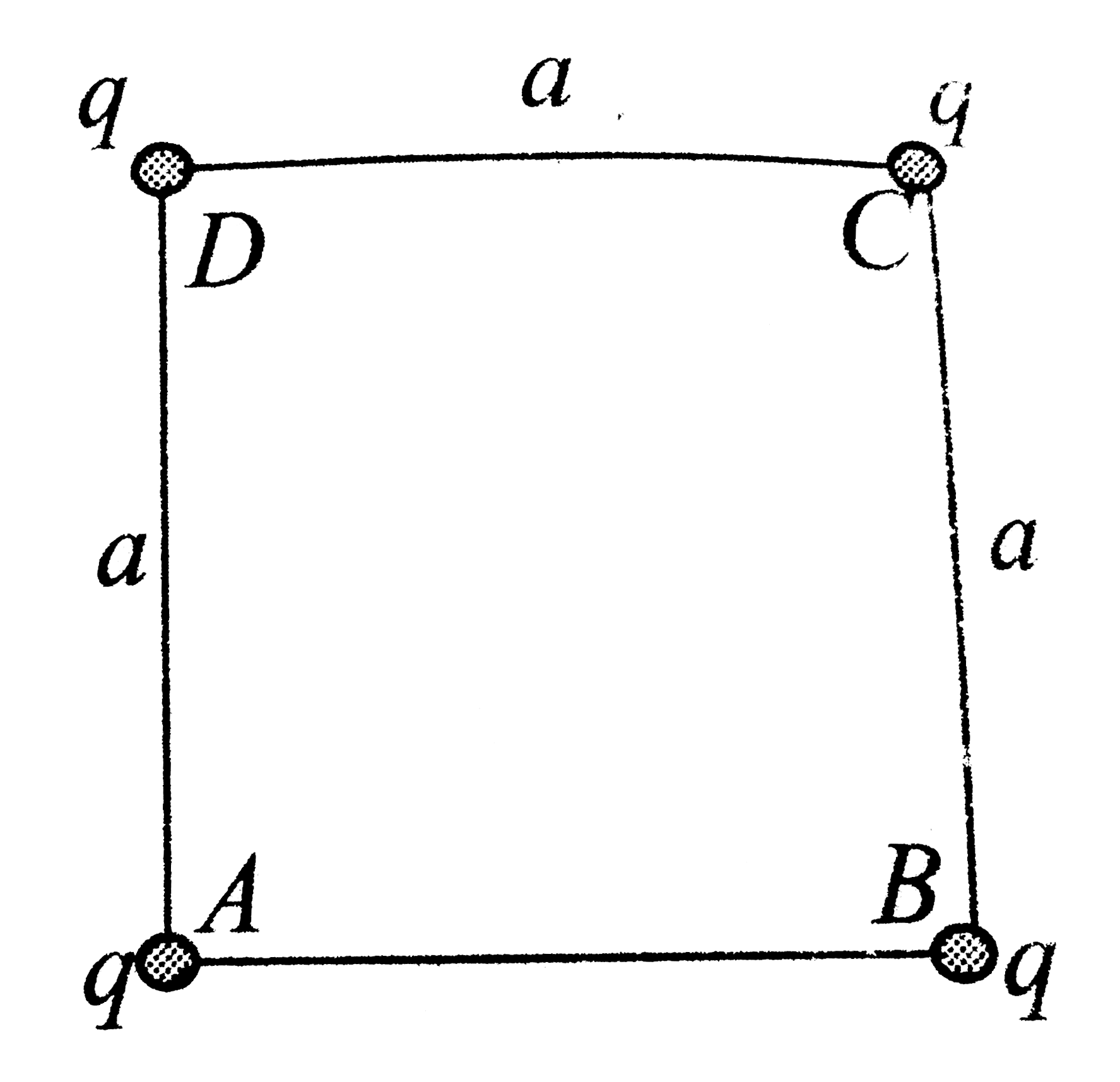Four identical charges i.e. q is placed at the corners of a square of side a. The charge Q that must be placed at the centre of the square such that the whole system of charges in equilibrium is
q4
q4[2√2+1]
−q4[2√2+1]
−q4[3√3+1]
The correct Answer is:3
To find the charge Q that must be placed at the center of a square with four identical charges q at its corners for the system to be in equilibrium, we can follow these steps:
Step 1: Understand the Configuration
We have four identical charges q placed at the corners of a square with side length a. We need to find the charge Q that should be placed at the center of the square.
Hint: Visualize the square and the positions of the charges. The center of the square is equidistant from all four corners.
Step 2: Determine the Forces Acting on the Charge at the Center
The charge Q at the center will experience forces due to each of the four corner charges q. The forces will be directed radially outward if Q is positive and inward if Q is negative.
Hint: Consider the symmetry of the problem. The forces from the corner charges will have components that can cancel out due to symmetry.
Step 3: Calculate the Distance from the Center to a Corner
The distance from the center of the square to one of its corners can be calculated using the Pythagorean theorem. The distance r from the center to a corner is given by:
r=a√2
Hint: Remember that the diagonal of the square can be found using the formula d=√2a, and the center divides this diagonal into two equal parts.
Step 4: Write the Expression for the Force on Charge Q
The force F on charge Q due to one corner charge q is given by Coulomb's law:
F=k|qQ|r2
Substituting r=a√2:
F=k|qQ|(a√2)2=k2|qQ|a2
Hint: Remember that k is Coulomb's constant and is necessary for calculating the force.
Step 5: Analyze the Forces for Equilibrium
For the system to be in equilibrium, the net force acting on charge Q must be zero. Since there are four identical charges q, the forces due to these charges will be equal in magnitude but opposite in direction.
The total force due to the four corner charges can be expressed as:
Fnet=4Fcos(45∘)=4(k2|qQ|a2)1√2=4√2k|qQ|a2
Hint: Use the angle to resolve the forces into components. The angle is 45∘ because of the symmetry of the square.
Step 6: Set the Forces Equal to Zero
For equilibrium, we need the force due to Q to balance the forces from the corner charges:
Fnet=0⟹4√2k|qQ|a2=0
This implies that Q must be negative to counteract the repulsive forces from the positive charges q.
Step 7: Solve for Charge Q
From the equilibrium condition, we can derive that:
Q=−q4(2√2+1)
Hint: Make sure to keep track of the signs. Since Q must be negative, we include the negative sign in the final expression.
Final Result
Thus, the charge Q that must be placed at the center of the square for the system to be in equilibrium is:
Q=−q4(2√2+1)
We have four identical charges q placed at the corners of a square with side length a. We need to find the charge Q that should be placed at the center of the square.
The charge Q at the center will experience forces due to each of the four corner charges q. The forces will be directed radially outward if Q is positive and inward if Q is negative.
The distance from the center of the square to one of its corners can be calculated using the Pythagorean theorem. The distance r from the center to a corner is given by:
r=a√2
The force F on charge Q due to one corner charge q is given by Coulomb's law:
F=k|qQ|r2
Substituting r=a√2:
F=k|qQ|(a√2)2=k2|qQ|a2
For the system to be in equilibrium, the net force acting on charge Q must be zero. Since there are four identical charges q, the forces due to these charges will be equal in magnitude but opposite in direction.
Fnet=4Fcos(45∘)=4(k2|qQ|a2)1√2=4√2k|qQ|a2
For equilibrium, we need the force due to Q to balance the forces from the corner charges:
Fnet=0⟹4√2k|qQ|a2=0
From the equilibrium condition, we can derive that:
Q=−q4(2√2+1)
Thus, the charge Q that must be placed at the center of the square for the system to be in equilibrium is:
Q=−q4(2√2+1)
Topper's Solved these Questions
Similar Questions
Knowledge Check
Equal charges q are placed at the three corners B, C, D of a square ABCD of side a. The potential at A is
A14πε0qaB3q4πε0Cq4πε0a[2+1√2]Dq4πε0a[1+√2]
A point charge Q is placed at the corner of a square of side a, then find the flux through the square.

View SolutionFour point charges are placed at the corners of a square ABCD of side 10 cm, as shown in figure. The force on a charge of 1μC placed at the centre of square is

View SolutionFour point charges are placed at the corners of a square of side l. Calculate potential at the centre of square.

View SolutionFour identical point charges q are placed at four corners of a square of side a. Find the potential energy of the charge system.
 .
.
View SolutionFour identical charges q are placed at the corners of a square of side a. Find the potential energy of one of the charges due to the remaining charges.
 .
.
View SolutionFour identical charges, Q each, are fixed at the vertices of a square. A free charge q is placed at the centre of the square. Investigate the nature of equilibrium of charge q if it is to be displaced slightly along any of the two diagonals of the square.
View SolutionFour point charges of +1μc each are placed on the four corners of a square of side 1 m. Calculate the electric potential at the centre of the square.
View Solution
